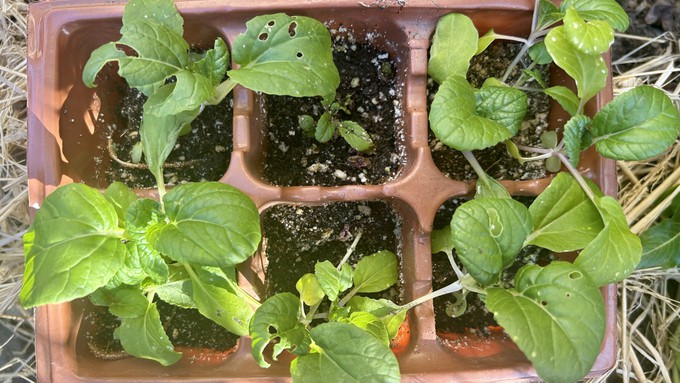
Much cooler temperatures coming soon; plant now!

This six-pack of baby pak choi (bok choy), grown from seed, is about ready to plant in its permanent spot. Kathy Morrison
Get ready for some much cooler weather. According to the National Weather Service, our current flashback to summer heat will end soon.
“Today’s warm temperatures are expected to stick around through the weekend,” tweeted the NWS Sacramento office on Saturday morning. “But by early next week, fall weather returns and our high temperatures drop 6-10 degrees below average!”
Saturday's forecast has a high of 94 degrees with 91 on Sunday. But by Sunday night, the ridge of high pressure holding in that warmth disappears, allowing clouds, wind and the possibility of rain to sweep across the Central Valley.
Monday’s forecast high: 69 degrees. That’s 25 degrees lower than Saturday’s expected high. Sacramento could also get damp on Monday afternoon with 0.13 inches of rain predicted by the weather service.
The remainder of the week will pleasantly be in the 70s – perfect planting weather! Overnight lows remain in the mid to high 50s, keeping soil warm and roots cozy. It’s the best combination for getting transplants off to a healthy start.
So, what are you waiting for? Plant something!
* Trees, shrubs and perennials planted now will develop deep, strong roots. This is the best time to transplant water-wise varieties.
* Divide and replant perennials. Add a little well-aged compost and bone meal to the planting hole, but hold off on other fertilizers until spring. Keep the transplants well-watered (but not wet) for the first month as they become settled.
* Now is the time to plant seeds for many flowers directly into the garden, including cornflower, nasturtium, nigella, poppy, portulaca, sweet pea and stock.
* Plant seeds for radishes, bok choy, mustard, spinach and peas.
* Plant garlic and onions.
* Set out cool-weather bedding plants, including calendula, pansy, snapdragon, primrose and viola.
* Reseed and feed the lawn. Work on bare spots.
* Dig up corms and tubers of gladioli, dahlias and tuberous begonias after the foliage dies. Clean and store in a cool, dry place.
* Treat azaleas, gardenias and camellias with chelated iron if leaves are yellowing between the veins.
* Clean up the summer vegetable garden and compost disease-free foliage.
* Harvest pumpkins and winter squash.
Comments
0 comments have been posted.Sacramento Digs Gardening to your inbox.
Sites We Like
Garden Checklist for week of April 21
This week there’s plenty to keep gardeners busy. With no rain in the immediate forecast, remember to irrigate any new transplants.
* Weed, weed, weed! Get them before they flower and go to seed.
* April is the last chance to plant citrus trees such as dwarf orange, lemon and kumquat. These trees also look good in landscaping and provide fresh fruit in winter.
* Smell orange blossoms? Feed citrus trees with a low dose of balanced fertilizer (such as 10-10-10) during bloom to help set fruit. Keep an eye out for ants.
* Apply slow-release fertilizer to the lawn.
* Thoroughly clean debris from the bottom of outdoor ponds or fountains.
* Spring brings a flush of rapid growth, and that means your garden is really hungry. Feed shrubs and trees with a slow-release fertilizer. Or mulch with a 1-inch layer of compost.
* Azaleas and camellias looking a little yellow? If leaves are turning yellow between the veins, give them a boost with chelated iron.
* Trim dead flowers but not leaves from spring-flowering bulbs such as daffodils and tulips. Those leaves gather energy to create next year's flowers. Also, give the bulbs a fertilizer boost after bloom.
* Pinch chrysanthemums back to 12 inches for fall flowers. Cut old stems to the ground.
* Mulch around plants to conserve moisture and control weeds.
* From seed, plant beans, beets, cantaloupes, carrots, corn, cucumbers, melons, radishes and squash.
* Plant onion sets.
* In the flower garden, plant seeds for asters, cosmos, celosia, marigolds, salvia, sunflowers and zinnias.
* Transplant petunias, zinnias, geraniums and other summer bloomers.
* Plant perennials and dahlia tubers for summer bloom.
* Mid to late April is about the last chance to plant summer bulbs, such as gladiolus and tuberous begonias.
* Transplant lettuce seedlings. Choose varieties that mature quickly such as loose leaf.